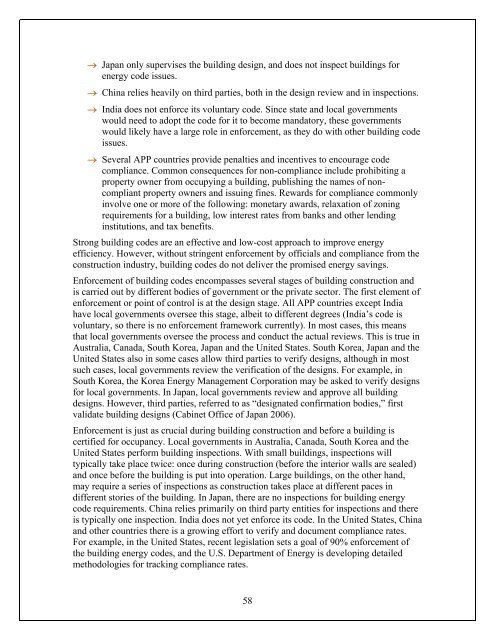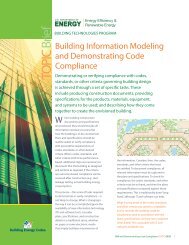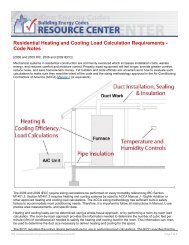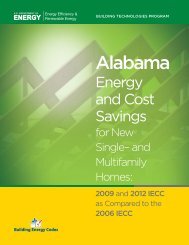Shaping the Energy Efficiency in New Buildings - Building Energy ...
Shaping the Energy Efficiency in New Buildings - Building Energy ...
Shaping the Energy Efficiency in New Buildings - Building Energy ...
You also want an ePaper? Increase the reach of your titles
YUMPU automatically turns print PDFs into web optimized ePapers that Google loves.
Japan only supervises <strong>the</strong> build<strong>in</strong>g design, and does not <strong>in</strong>spect build<strong>in</strong>gs forenergy code issues. Ch<strong>in</strong>a relies heavily on third parties, both <strong>in</strong> <strong>the</strong> design review and <strong>in</strong> <strong>in</strong>spections. India does not enforce its voluntary code. S<strong>in</strong>ce state and local governmentswould need to adopt <strong>the</strong> code for it to become mandatory, <strong>the</strong>se governmentswould likely have a large role <strong>in</strong> enforcement, as <strong>the</strong>y do with o<strong>the</strong>r build<strong>in</strong>g codeissues. Several APP countries provide penalties and <strong>in</strong>centives to encourage codecompliance. Common consequences for non-compliance <strong>in</strong>clude prohibit<strong>in</strong>g aproperty owner from occupy<strong>in</strong>g a build<strong>in</strong>g, publish<strong>in</strong>g <strong>the</strong> names of noncompliantproperty owners and issu<strong>in</strong>g f<strong>in</strong>es. Rewards for compliance commonly<strong>in</strong>volve one or more of <strong>the</strong> follow<strong>in</strong>g: monetary awards, relaxation of zon<strong>in</strong>grequirements for a build<strong>in</strong>g, low <strong>in</strong>terest rates from banks and o<strong>the</strong>r lend<strong>in</strong>g<strong>in</strong>stitutions, and tax benefits.Strong build<strong>in</strong>g codes are an effective and low-cost approach to improve energyefficiency. However, without str<strong>in</strong>gent enforcement by officials and compliance from <strong>the</strong>construction <strong>in</strong>dustry, build<strong>in</strong>g codes do not deliver <strong>the</strong> promised energy sav<strong>in</strong>gs.Enforcement of build<strong>in</strong>g codes encompasses several stages of build<strong>in</strong>g construction andis carried out by different bodies of government or <strong>the</strong> private sector. The first element ofenforcement or po<strong>in</strong>t of control is at <strong>the</strong> design stage. All APP countries except Indiahave local governments oversee this stage, albeit to different degrees (India’s code isvoluntary, so <strong>the</strong>re is no enforcement framework currently). In most cases, this meansthat local governments oversee <strong>the</strong> process and conduct <strong>the</strong> actual reviews. This is true <strong>in</strong>Australia, Canada, South Korea, Japan and <strong>the</strong> United States. South Korea, Japan and <strong>the</strong>United States also <strong>in</strong> some cases allow third parties to verify designs, although <strong>in</strong> mostsuch cases, local governments review <strong>the</strong> verification of <strong>the</strong> designs. For example, <strong>in</strong>South Korea, <strong>the</strong> Korea <strong>Energy</strong> Management Corporation may be asked to verify designsfor local governments. In Japan, local governments review and approve all build<strong>in</strong>gdesigns. However, third parties, referred to as “designated confirmation bodies,” firstvalidate build<strong>in</strong>g designs (Cab<strong>in</strong>et Office of Japan 2006).Enforcement is just as crucial dur<strong>in</strong>g build<strong>in</strong>g construction and before a build<strong>in</strong>g iscertified for occupancy. Local governments <strong>in</strong> Australia, Canada, South Korea and <strong>the</strong>United States perform build<strong>in</strong>g <strong>in</strong>spections. With small build<strong>in</strong>gs, <strong>in</strong>spections willtypically take place twice: once dur<strong>in</strong>g construction (before <strong>the</strong> <strong>in</strong>terior walls are sealed)and once before <strong>the</strong> build<strong>in</strong>g is put <strong>in</strong>to operation. Large build<strong>in</strong>gs, on <strong>the</strong> o<strong>the</strong>r hand,may require a series of <strong>in</strong>spections as construction takes place at different paces <strong>in</strong>different stories of <strong>the</strong> build<strong>in</strong>g. In Japan, <strong>the</strong>re are no <strong>in</strong>spections for build<strong>in</strong>g energycode requirements. Ch<strong>in</strong>a relies primarily on third party entities for <strong>in</strong>spections and <strong>the</strong>reis typically one <strong>in</strong>spection. India does not yet enforce its code. In <strong>the</strong> United States, Ch<strong>in</strong>aand o<strong>the</strong>r countries <strong>the</strong>re is a grow<strong>in</strong>g effort to verify and document compliance rates.For example, <strong>in</strong> <strong>the</strong> United States, recent legislation sets a goal of 90% enforcement of<strong>the</strong> build<strong>in</strong>g energy codes, and <strong>the</strong> U.S. Department of <strong>Energy</strong> is develop<strong>in</strong>g detailedmethodologies for track<strong>in</strong>g compliance rates.58
















